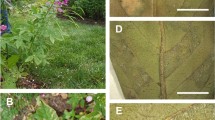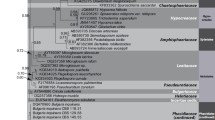Abstract
A new species of Peronospora is described from Gymnospermium odessanum, a rare spring geophyte considered a Tertiary relict in the northwestern Black Sea region of Ukraine, Moldova and Romania. Phylogenetic analyses based on a combined matrix of the internal transcribed spacer-large subunit (ITS-LSU) ribosomal DNA (rDNA) and the mitochondrial cytochrome c oxidase subunit 1 (cox1) and cox2 genes demonstrate that it is a clearly distinct undescribed species. Morphological descriptions and illustrations of its oospores, conidiophores and conidia are provided. Despite its distinctive disease symptoms, the species has remained undetected until now, probably due to the rarity of its host. Peronospora odessana is the second species from Berberidaceae and is morphologically clearly distinct from P. achlydis on Achlys japonicus. The closest relatives of P. odessana were not revealed, but it is closely related to Peronospora bulbocapni, P. dicentrae and P. chrysosplenii, the hosts of which are also spring geophytes. Sequence data confirm that cox1 and cox2 are good barcoding loci; they show a similar number of nucleotide differences to its closest relatives.


Similar content being viewed by others
References
Angiosperm Phylogeny Group (2009) An update of the angiosperm phylogeny group classification for the orders and families of flowering plants: APG III. Bot J Linn Soc 161:105–121
Bonants P, Hagenaar-de Weerdt M, van Gent-Pelzer M, Lacourt I, Cooke D, Duncan J (1997) Detection and identification of Phytophthora fragariae Hickman by the polymerase chain reaction. Eur J Plant Pathol 103:345–355
Choi YJ, Constantinescu O, Shin HD (2007a) A new downy-mildew of the Rosaceae: Peronospora oblatispora sp. nov. (Chromista, Peronosporales). Nova Hedwigia 85:93–101
Choi YJ, Hong SB, Shin HD (2007b) Re-consideration of Peronospora farinosa infecting Spinacia oleracea as distinct species, Peronospora effusa. Mycol Res 110:381–391
Choi YJ, Shin HD, Thines M (2009) Two novel Peronospora species are associated with recent reports of downy mildew on sages. Mycol Res 113:1340–1350
Choi YJ, Shin HD, Voglmayr H (2011a) Reclassification of two Peronospora species parasitic on Draba in Hyaloperonospora based on morphological molecular and phylogenetic data. Mycopathologia 171:151–159
Choi YJ, Thines M, Runge F, Hong SB, Telle S, Shin HD (2011b) Evidence for high degrees of specialisation, evolutionary diversity, and morphological distinctiveness in the genus Bremia. Fungal Biol 115:102–111
Constantinescu O (1991) An annotated list of Peronospora names. Thunbergia 15:1–110
Didukh Y. P. (ed.) (2009) Red data book of Ukraine. Vegetable kingdom. 912 pp. Globalconsalting, Kiew, Ukraine
García Blázquez G, Göker M, Voglmayr H, Martín MP, Tellería MT, Oberwinkler F (2008) Phylogeny of Peronospora, parasitic on Fabaceae, based on ITS sequences. Mycol Res 112:502–512
Göker M, Riethmüller A, Voglmayr H, Weiß M, Oberwinkler F (2004) Phylogeny of Hyaloperonospora based on nuclear ribosomal internal transcribed spacer sequences. Mycol Prog 3:83–94
Göker M, Voglmayr H, García Blázquez G, Tellería MT, Martín MP (2009) Molecular taxonomy of phytopathogenic fungi: a case study in Peronospora. PLoS ONE 4, e6319
Hall TA (1999) BioEdit: a user-friendly biological sequence alignment editor and analysis. Program for windows 95/98/NT. Nucleic Acids Symp Ser 41:95–98
Hasegawa M, Kishino H, Yano T (1985) Dating of the human-ape splitting by a molecular clock of mitochondrial DNA. J Mol Evol 22:160–174
Holubec V, Krivka P (2006) The Caucasus and its flowers. Loxia, Pardubice, Czech Republic. 390 pp
Hudspeth DSS, Nadler SA, Hudspeth MES (2000) A cox2 phylogeny of the Peronosporomycetes (Oomycetes). Mycologia 92:674–684
Huelsenbeck JP, Ronquist F (2001) MRBAYES: Bayesian inference of phylogenetic trees. Bioinformatics 17:754–755
Ito S, Tokunaga Y (1935) Notae mycologicae asiae orientalis I. Trans Sapporo Nat Hist Soc 14:11–33
Nylander JA, Wilgenbusch JC, Warren DL, Swofford DL (2008) AWTY (are we there yet?): a system for graphical exploration of MCMC convergence in Bayesian phylogenetics. Bioinformatics 24:581–583
Oprea A, Goia I, Tănase C, Sîrbu C (2010) Assessment of species composition: endemics, relicts and red-listed plants (Tracheophytae, Bryophytae, and Fungi) in forest natural habitats of Romania. Contrib Bot 45:13–24
Posada D, Crandall KA (1998) Modeltest: testing the model of DNA substitution. Bioinformatics 14:817–818
Riethmüller A, Voglmayr H, Göker M, Weiβ M, Oberwinkler F (2002) Phylogenetic relationships of the downy mildews (Peronosporales) and related groups based on nuclear large subunit ribosomal DNA sequences. Mycologia 94:834–849
Robideau GP, de Cock AWAM, Coffey MD, Voglmayr H, Brouwer H, Bala K, Chitty DW, Désaulniers N, Eggertson QA, Gachon CMM, Hu CH, Küpper FC, Rintoul TL, Sarhan E, Verstappen ECP, Zhang Y, Bonants PJM, Ristaino JB, Lévesque CA (2011) DNA barcoding of oomycetes with cytochrome c oxidase subunit I and internal transcribed spacer. Mol Ecol Resour 11:1002–1011
Rouxel M, Mestre P, Comont G, Lehman BL, Schilder A, Delmotte F (2013) Phylogenetic and experimental evidence for host-specialized cryptic species in a biotrophic oomycete. New Phytol 197:251–263
Runge F, Choi YJ, Thines M (2011) Phylogenetic investigations in the genus Pseudoperonospora reveal overlooked species and cryptic diversity in the P. cubensis species cluster. Eur J Plant Pathol 129:135–146
Schröder S, Telle S, Nick P, Thines M (2011) Cryptic diversity of Plasmopara viticola (Oomycota, Peronosporaceae) in North America. Org Divers Evol 11:3–7
Silvestro D, Michalak I (2012) raxmlGUI: a graphical front-end for RAxML. Org Divers Evol 12:335–337
Stamatakis E (2006) RAxML-VI-HPC: maximum likelihood-based phylogenetic analyses with thousands of taxa and mixed models. Bioinformatics 22:2688–2690
Sung GH, Sung JM, Hywel-Jones NL, Spatafora JW (2007) A multi-gene phylogeny of Clavicipitaceae (Ascomycota, Fungi): Identification of localized incongruence using a combinational bootstrap approach. Mol Phylogenet Evol 44:1204–1223
Swofford DL (2002) PAUP*: phylogenetic analysis using parsimony (*and other methods) Version 4.0b10. Sinauer Associates, Sunderland, MA
Tan K, Shuka L, Siljak-Yakovlev S, Malo S, Pustahija F (2011) The genus Gymnospermium (Berberidaceae) in the Balkans. Phytotaxa 25:1–17
Thiers B (2014) Index Herbariorum: A global directory of public herbaria and associated staff. New York Botanical Garden’s Virtual Herbarium. http://sweetgum.nybg.org/ih/
Thines M (2011) Recent outbreaks of downy mildew on grape ivy (Parthenocissus tricuspidata, Vitaceae) in Germany are caused by a new species of Plasmopara. Mycol Prog 10:415–422
Thines M (2014) Phylogeny and evolution of plant pathogenic oomycetes—a global overview. Eur J Plant Pathol 138:431–447
Thines M, Kummer V (2013) Diversity and species boundaries in floricolous downy mildews. Mycol Prog 12:321–329
Thines M, Telle S, Ploch S, Runge F (2009a) Identity of the downy mildew pathogens of basil, coleus, and sage with implications for quarantine measures. Mycol Res 113:532–540
Thines M, Voglmayr H, Göker M (2009b) Taxonomy and phylogeny of the downy mildews (Peronosporaceae). In: Lamour K, Kamoun S (eds) Oomycete genetics and genomics: diversity, interactions, and research tools. Wiley, Weinheim, pp 47–75
Thines M, Runge F, Telle S, Voglmayr H (2010) Phylogenetic investigations in the downy mildew genus Bremia reveal several distinct lineages and a species with a pesumably exceptional wide host range. Eur J Plant Pathol 128:81–89
Voglmayr H (2003) Phylogenetic study of Peronospora and related genera based on nuclear ribosomal ITS sequences. Mycol Res 107:1132–1142
Voglmayr H (2008) Progress and challenges in systematics of downy mildews and white blister rusts: new insights from genes and morphology. Eur J Plant Pathol 122:3–18
Voglmayr H, Göker M (2011) Morphology and phylogeny of Hyaloperonospora erophilae and H. praecox sp. nov., two downy mildew species co-occurring on Draba verna sensu lato. Mycol Prog 10:283–292
Voglmayr H, Jaklitsch W (2008) Prosthecium species with Stegonsporium anamorphs on Acer. Mycol Res 112:885–905
Voglmayr H, Choi YJ, Shin HD (2014a) Multigene phylogeny, taxonomy and reclassification of Hyaloperonospora on Cardamine. Mycol Prog 13:131–144
Voglmayr H, Montes-Borrego M, Landa BB (2014b) Disentangling Peronospora on Papaver: species delimitation, taxonomy and host range inferred from molecular phylogeny and morphology. PLoS ONE 9(5), e96838
Wang W, Chen ZD, Liu Y, Li RQ, Li JH (2007) Phylogenetic and biogeographic diversification of Berberidaceae in the Northern Hemisphere. Syst Bot 32:731–742
Werle E, Schneider C, Renner M, Völker M, Fiehn W (1994) Convenient single-step, one tube purification of PCR products for direct sequencing. Nucleic Acids Res 22:4354–4355
White TJ, Bruns T, Lee S, Taylor JW (1990) Amplification and direct sequencing of fungal ribosomal RNA genes for phylogenetics. In: Innis MA Gelfand DH, Sninsky JJ, White TJ (eds) PCR protocols, a guide to methods and application. Academic, London, pp 315–322
Wiens JJ (1998) Combining data sets with different phylogenetic histories. Syst Biol 47:568–581
Acknowledgments
This study was supported by the Austrian Science Fund (FWF; project P22739-B20). Kit Tan is gratefully acknowledged for providing information on Gymnospermium maloi.
Author information
Authors and Affiliations
Corresponding author
Rights and permissions
About this article
Cite this article
Voglmayr, H., Korytnianska, V.G. Peronospora odessana sp. nov., a downy mildew pathogen of a Tertiary relict species, Gymnospermium odessanum . Mycol Progress 14, 36 (2015). https://doi.org/10.1007/s11557-015-1059-6
Received:
Revised:
Accepted:
Published:
DOI: https://doi.org/10.1007/s11557-015-1059-6




